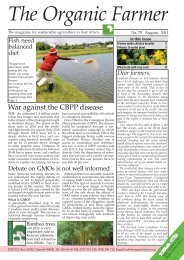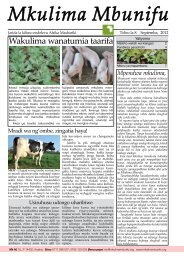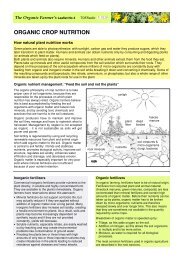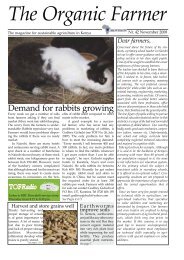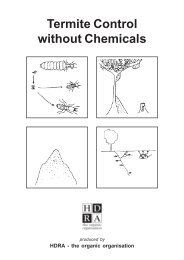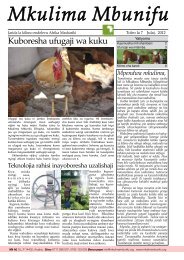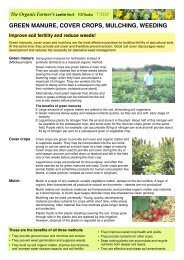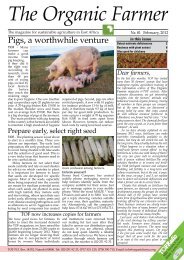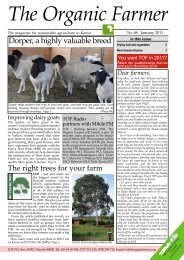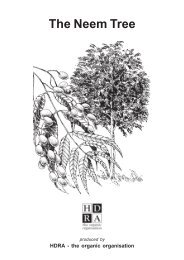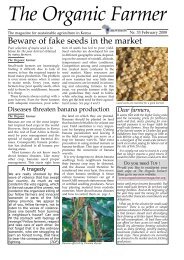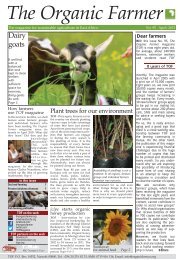TOF, Issue No 07, November 2005 - Infonet-Biovision
TOF, Issue No 07, November 2005 - Infonet-Biovision
TOF, Issue No 07, November 2005 - Infonet-Biovision
Create successful ePaper yourself
Turn your PDF publications into a flip-book with our unique Google optimized e-Paper software.
The Organic Farmer<br />
The newspaper for sustainable agriculture in Kenya Nr. 7 <strong>No</strong>vember <strong>2005</strong><br />
Disease threatens Napier Grass<br />
In the last<br />
decade,<br />
cultivation of<br />
Napier grass has<br />
boomed in East<br />
Africa, as smallscale<br />
farmers<br />
have shifted to<br />
zero grazing.<br />
With the<br />
expansion of this<br />
fodder crop,<br />
however, has<br />
come a new<br />
disease called<br />
'Napier Stunt'.<br />
The disease<br />
causes healthy<br />
thick Napier<br />
grass leaves to<br />
turn thin, yellow<br />
and weak; a<br />
special indication<br />
of the disease are<br />
the short<br />
internodes as the<br />
picture shows.<br />
The disease has been present in<br />
eastern Africa for about 30 years<br />
but it has become more noticeable<br />
in the last few years. If nothing is<br />
done, this disease will seriously<br />
affect the livestock industry in<br />
eastern Africa, including Ethiopia.<br />
In parts of eastern Uganda and<br />
western Kenya, market prices for<br />
fodder grass have doubled in the last<br />
In this issue<br />
The “wild” friend of farmers<br />
With Tithonia you can<br />
maintain soil fertility Page 2<br />
The two terrible blights<br />
Prevention is the way to control<br />
early and late blight. Page 3<br />
Beans of high value<br />
Farmers are now discovering the<br />
benefits of Soya beans. Page 8<br />
year; the farmers have been forced<br />
to buy grass to compensate for<br />
declining production. While a<br />
healthy acre of Napier grass should<br />
provide enough feed to sustain four<br />
productive cows, plots affected by<br />
the disease may support only one<br />
or two animals, greatly reducing<br />
milk yields and income for Kenyan<br />
farmers. See page 5.<br />
Insemination too costly<br />
Small-scale farmers trying to<br />
improve their livestock breeds are<br />
faced with a big challenge. The<br />
private providers of Artificial<br />
Insemination services charge<br />
between Ksh 600 to Ksh 1000. Most<br />
farmers cannot afford to pay this<br />
amount. Preservation equipment<br />
for semen handling has to be<br />
imported. Kenya used to make its<br />
own nitrogen for preservation, but<br />
the plant broke down after donor<br />
support was withdrawn. Plant<br />
rehabilitation is important to make<br />
the service affordable. (<strong>TOF</strong>)<br />
Dear farmers,<br />
While travelling around the country in<br />
the last few weeks, we have had many<br />
fruitful discussions with farmers in<br />
various regions. Similarly, we have<br />
received letters, telephone calls and<br />
short messages, all commending and<br />
encouraging us to continue producing<br />
the newspaper.<br />
We have seen many farmers who are<br />
taking our advice seriously. However,<br />
we still feel that farmers can do more.<br />
Take the problem of marketing, for<br />
example. After receiving many<br />
questions three months ago from<br />
farmers on where they could sell their<br />
organic produce, we created a column<br />
called "THE MARKET PLACE",<br />
where farmers with any produce to offer<br />
could advertise their products. One of<br />
the buyers, Su Kahumbu, even put an<br />
advert in our newspaper asking farmers<br />
to contact her if they had anything to<br />
sell. Up to now not a single farmer has<br />
done so. Recently, farmers have written<br />
to us again with queries on where they<br />
could sell their products! Of course, we<br />
know that Kenyan farmers face<br />
enormous hurdles as they try to find a<br />
market for their produce. However,<br />
they can make better use of the column<br />
in our newspaper to look for buyers.<br />
Most Kenyan farmers are hard<br />
working people. But to be a successful<br />
farmer in today's world, one has to be<br />
aware of the changing market<br />
demands. The problem is that there is a<br />
generation of farmers who do not accept<br />
change; to them, farming will remain a<br />
loss-making enterprise as it has always<br />
been. On the other hand, it is<br />
encouraging to see an upcoming<br />
generation of young farmers in many<br />
parts of the country. They have adopted<br />
the latest farming methods, and raise<br />
several different crops. They grow what<br />
the markets needs every season. If you<br />
read the story on page 4 in this issue, you<br />
will understand what we are talking<br />
about. A lot of things will change if<br />
farmers will be a little bit more<br />
forward-looking. We as editors will<br />
continue to support your efforts in<br />
making organic farming the most<br />
sustainable method of agriculture in the<br />
country.
2 The Organic Farmer Nr. 7 <strong>No</strong>vember <strong>2005</strong><br />
MY OPINION<br />
By Michael Wafula<br />
Many of us farmers do not take<br />
the health of our animals<br />
seriously. Everywhere you go<br />
you find people grazing their<br />
animals by the roadside. Most of<br />
these farmers have enough land,<br />
on which they can plant fodder<br />
crops such as Napier grass. But<br />
they choose to spare the land for<br />
other uses. If the quality of the<br />
grass is poor, so the quality of<br />
milk produced will be poor.<br />
Fellow farmers, let us feed our<br />
animals properly, they will pay<br />
back by producing more milk for<br />
our consumption and even sale.<br />
Michael Wafula is a farmer in Kitale<br />
The Organic Farmer<br />
Nr. 7, <strong>No</strong>vember <strong>2005</strong><br />
The Organic Farmer is an<br />
independent newspaper for the<br />
Kenyan farming community. It<br />
promotes organic farming and<br />
supports discussions on all aspects of<br />
sustainable development. The<br />
Organic Farmer is published<br />
monthly and distributed free to<br />
farmers.<br />
The reports of The Organic Farmer<br />
do not necessarily reflect the views<br />
of ICIPE.<br />
The Organic Farmer is sponsored by<br />
BioVision, a Swiss based foundation<br />
for the promotion of sustainable<br />
development.<br />
www.biovision.ch<br />
Publisher<br />
International Centre of Insect<br />
Physiology and Ecology (ICIPE)<br />
P.O.Box 3<strong>07</strong>72, 00100 Nairobi<br />
KENYA<br />
Tel. +254 20 863 2000<br />
e-mail: icipe@icipe.org<br />
homepage: http://www.icipe.org<br />
Editors<br />
Peter Kamau, Peter Baumgartner<br />
Secretariat<br />
Lucy W. Macharia<br />
Advisory Board<br />
Dr. Bernhard Löhr, ICIPE<br />
Dr. Nguya Maniania, ICIPE<br />
Dr. Fritz Schulthess, ICIPE<br />
Address<br />
The Organic Farmer<br />
P.O.Box 14352, 00800 Nairobi<br />
KENYA<br />
Tel. 020 445 03 98<br />
e-mail : info@organickenya.com<br />
Layout:<br />
James Wathuge<br />
Organic farmer's “wild” “ friend<br />
Tithonia, or wild sunflower, is easy<br />
to grow and is rich in phosphorus<br />
and nitrogen.<br />
By Daniel Wanjama<br />
Tithonia diversifolia, a nice wild<br />
shrub with yellow flowers, is found<br />
almost all over Kenya. It is often<br />
used as a hedge plant and grows wild<br />
in roadsides near rivers and on waste<br />
ground. Over the years some rural<br />
communities of Kenya have known<br />
Tithonia as a remedy for stomach<br />
ailments; farmers used it on fences or<br />
on ridges to check surface runoffs.<br />
Alternative to chemical fertilizer<br />
They were however unaware of its<br />
potential to enhance soil fertility.<br />
Research scientists explain that the<br />
Tithonia plant contains 80 per cent<br />
more phosphorus than legumes. It<br />
also contains enough nitrogen and<br />
potassium to promote crop growth.<br />
So Tithonia is an alternative to<br />
chemical fertilizers. 5 tonnes of the<br />
green foliage in-corporated into 1<br />
hectare of land is equivalent to<br />
applying the following rates of<br />
inorganic fertilizer: 159kg Nitrogen,<br />
10kg Phosphorus, 161kg Potassium,<br />
18kg Calcium, 22kg Magnesium.<br />
The most popular application is in<br />
the making of compost where it is<br />
used with dry plant material. It feeds<br />
microorganism with phosphorus<br />
and nitrogen. But you can also use it<br />
directly by slashing young plants and<br />
incorporating the green foliage in the<br />
soil at any cultivation stage.<br />
In western parts of Kenya it is used<br />
against termites, and scientists<br />
discovered that powder and extract<br />
of Tithonia is a repellant and has<br />
been found to be an effective<br />
biopesticide against cow pea seed<br />
beetle.<br />
Plant tea<br />
Tithonia is also used in making plant<br />
tea (plant extract) for top dressing.<br />
Chop Tithonia vegetative parts and<br />
soak them in the water at a ratio of 1<br />
part in 4 parts of water. Let it stand<br />
in a tightly covered container for at<br />
least 7 days. Apply it within the 5<br />
days diluting it with equal amount of<br />
water and spread at the root base of<br />
the desired plant.<br />
Why use Tithonia?<br />
• It is used in compost making<br />
because it is rich in phosphorus<br />
and nitrogen.<br />
• Tithonia plant grows very fast<br />
enough to supply quantity<br />
materials through out the season.<br />
• Tithonia has the ability to regrow<br />
after cutting, which ensure<br />
continuous supply of vegetations.<br />
• It is a wild plant, which requires<br />
little or no attention from the<br />
farmer.<br />
• Tithonia decompose fast because<br />
it has succulent tissues.<br />
• Tithonia plant is easy to handle<br />
and cut.<br />
• Propagates vegetatively through<br />
stem cutting, which makes it<br />
establishment easier.<br />
• It is also used as fodder for goats.<br />
• When used for making hedges<br />
tithonia flowers attracts beneficial<br />
insects e.g. wasps and bees which<br />
are important in crop pollination.<br />
• The plant also forms a thick<br />
hedge.<br />
• It allows other crops near the<br />
hedge to grow without<br />
interference. The flowers also<br />
look nice in the garden.<br />
Dear Farmers,<br />
Paul Ndung'u, a small scale farmer<br />
from Molo, gave us the idea for this<br />
article on Tithonia. He has a<br />
beautiful Tithonia hedge around his<br />
shamba. He uses Tithonia hedges to<br />
separate the various crops such as<br />
maize, cabbages, tomatoes, peas and<br />
beans in the shamba. They do not<br />
only help to break the wind, they<br />
also reduce the spread of pests from<br />
one crop to the other. Of course,<br />
Ndung'u also uses the Tithonia<br />
leaves to enrich the soil.<br />
If you know of any other plant that<br />
has the same useful purpose as the<br />
Tithonia, write to us and let us share<br />
your experience with other farmers<br />
in the country. ( <strong>TOF</strong> )
In organic production systems,<br />
prevention is the best way<br />
to control the two diseases<br />
By The Organic Farmer<br />
Early and late blight diseases give<br />
farmers a lot of headache, as we<br />
discovered in our many discussions<br />
with farmers when we visited them<br />
in the last few weeks. Many other<br />
farmers have also called us with<br />
questions on how they can protect<br />
their crops from these diseases.<br />
Although we provided some<br />
information on this subject in the<br />
July issue, we have decided to revisit<br />
the topic to make it easier for<br />
farmers to diagnose these diseases<br />
and take preventive measures.<br />
Careful observation of the plant is<br />
the best way farmers can tell which<br />
of the two fungal diseases is<br />
affecting their crops so that they can<br />
deal with them. Below are some<br />
control methods farmers can use.<br />
Early blight<br />
In our July issue Su Kahumbu gave<br />
an account of her own struggles<br />
with the early blight. She has<br />
managed to control the disease by<br />
spraying the tomatoes with milk<br />
(diluted with water at the ratio of<br />
1:10). To strengthen the plants, she<br />
has used seaweed foliar feed<br />
together with EM2 (Effective<br />
Microorganisms). The German<br />
Information Service OISAT<br />
(www.oisat.org) recommends use of<br />
Marigold extract for the same<br />
purpose (see box on page 6). What<br />
can a small-scale organic farmer do<br />
to avoid losing their crop? If the<br />
milk solution does not help, one<br />
can apply copper, as you can see<br />
below.<br />
Late blight<br />
Even worse than early blight are the<br />
consequences of late blight. This is<br />
the most devastating of the two<br />
diseases affecting both organic and<br />
conventional potato and tomato<br />
production. It is spread by wind and<br />
rain<br />
Ṁany well known agricultural<br />
research institutions in Europe have<br />
done a lot of research on early and<br />
late blight. However, they have not<br />
found any effective treatment so far<br />
- except the use of copper. Up to<br />
now there are no successful organic<br />
control methods available when a<br />
crop is already infected with early<br />
and late blight. The use of organic<br />
The Organic Farmer Nr. 7 <strong>No</strong>vember <strong>2005</strong><br />
How to identify early and late blight<br />
Early blight<br />
Caused by a fungus called Alternaria<br />
solani<br />
Symptoms on leaves include:<br />
- Small brownish black spots, mainly<br />
on older leaves.<br />
- Yellowing of tissues surrounding the<br />
lesions.<br />
- Concentric rings in dark brownish<br />
portions of the lesions.<br />
- Dropping of leaves.<br />
Symptoms on stems include:<br />
- Small, dark, and slightly sunken<br />
wounds (lesions).<br />
- Pronounced concentric rings in<br />
enlarged (mature) lesions with light<br />
coloured centres.<br />
control methods has only worked<br />
in laboratories but has failed in field<br />
trials. That is why nearly all<br />
European countries allow the<br />
application of copper in biological<br />
agriculture. But copper is harmful<br />
to human beings, animals and even<br />
soils. The European Union has<br />
reduced the use of copper to 3-4<br />
kg/ha, but plans to replace it<br />
altogether in future. The Kenya<br />
Bureau of Standards knows about<br />
the problem of late blight and<br />
allows copper use in organic<br />
production (Draft Kenya Standard,<br />
Annex B, Kebs April <strong>2005</strong>). In<br />
Kenya, farmers are advised to use<br />
copper oxychloride 50WP at the<br />
rate of 2-3 kg/ha in 1000 litres of<br />
water sprayed on tomatoes and 3-6<br />
kg /ha in 1000 litres of water. Please<br />
read the labels carefully. It is<br />
available in agro-veterinary shops.<br />
Take preventive measures<br />
As we have explained earlier,<br />
control of late blight, once it has<br />
affected the crop, is very difficult.<br />
But farmers can take a number of<br />
measures to prevent it or to ensure<br />
it does not spread to the other<br />
healthy plants. First of all, farmers<br />
need to know that supporting<br />
tomato plants with sticks is very<br />
important. The sticks prevent the<br />
leaves from coming into contact<br />
with the disease-causing fungus,<br />
which is mainly deposited by wind<br />
and running water on top soils or<br />
on the lower surface of the plant.<br />
Some varieties of tomatoes do not<br />
require propping with sticks and<br />
these are the ones most prone to<br />
infection. Growers using these<br />
varieties should find ways of raising<br />
the plants from the ground to<br />
prevent the disease.<br />
They should observe the following<br />
guidelines:<br />
- When watering the plants, do not<br />
water the leaves. Water the base of<br />
the plant or direct the watering<br />
hose diagonally to the ground to<br />
reach the roots. If the leaves are<br />
infected, wetting them facilitates<br />
the spread of the disease to the soil<br />
(which could also infect potato<br />
tubers).<br />
- Remove and burn infected areas<br />
and plants as soon as infection is<br />
detected.<br />
- Avoid growing potatoes or<br />
tomatoes in the same field year<br />
after year. New tomato fields<br />
should be far away from old fields<br />
to stop transfering the disease to<br />
new crops.<br />
- Always grow tomatoes or potatoes<br />
in fields where other crops, which<br />
cannot be affected by early or late<br />
blight, were planted in the<br />
previous season. This crop<br />
rotation helps to reduce the disease<br />
from plant residues.<br />
- Use clean and disinfected seeds.<br />
Late blight<br />
Caused by a fungus called Phytophthora<br />
infestans<br />
Symptoms on leaves and stems include:<br />
- Irregular spots with a water-soaked<br />
appearance.<br />
- Enlargement of the spots into pale<br />
green to brown lesions that may cover<br />
large areas.<br />
- Whitish to grey moldy growth on the<br />
underside of leaves under moist<br />
conditions.<br />
- Browning, shrivelling and death of<br />
affected leaves.<br />
Symptoms on fruits include:<br />
- Irregular, dark, water-soaked lesions<br />
with a greasy appearance.<br />
3
4 The Organic Farmer Nr. 7 <strong>No</strong>vember <strong>2005</strong><br />
Diversification changes farmer's fortune<br />
He took technical advice seriously<br />
and today he is one of the most<br />
successful farmers in Kisii district<br />
By Peter Kamau, Kisii<br />
For 36-year-old Ronald Nyagaka,<br />
farming in the hilly highlands of<br />
Kiogoro division of Kisii district had<br />
been a continuous nightmare of lossmaking<br />
ventures. Despite striving<br />
hard, crop yields in his three-acre<br />
farm dwindled while prices kept<br />
falling.<br />
He grew maize for successive years<br />
on a large portion of the farm, but<br />
the prices were discouraging. When<br />
he ventured into tomato farming,<br />
disaster struck. This was three years<br />
ago when his entire tomato crop was<br />
wiped out by a "strange disease".<br />
He heeded advice<br />
But unlike fellow villagers who<br />
would have explained it away as the<br />
work of an evil spell, Ronald sought<br />
advice from the local Ministry of<br />
Agriculture office in Kisii town, 6<br />
km away. It is then that he developed<br />
a working relationship with the<br />
agricultural extension personnel.<br />
Nyagaka is now a beneficiary of the<br />
second phase of the National<br />
Agriculture and Livestock Extension<br />
Programme (NALEP II), a project<br />
funded by the Swedish International<br />
Development Agency which is<br />
trying to revive agricultural<br />
extension services to Kenyan<br />
farmers.<br />
"We visited his farm and diagnosed<br />
the problem to be bacterial wilt. We<br />
advised him to practise crop rotation<br />
and diversification to check diseases<br />
and boost his earnings", says Atieno<br />
Achieng, the divisional agricultural<br />
extension officer.<br />
The hardworking father of four<br />
heeded the advice from the official<br />
and went to work immediately. The<br />
results were tremendous and now<br />
Feeding the fish<br />
(Photo <strong>TOF</strong>)<br />
Nyagaka tends the tomato crop at his farm in Chinch<br />
Nyagaka is the envy of many a farmer<br />
in the neighbourhood and afar.<br />
Many different crops<br />
His farm, perched on a steep hillside,<br />
now holds a healthy crop of bulb<br />
onions, sukumawiki (kale), tissue<br />
culture bananas, improved orangefresh<br />
sweet potatoes, passion fruits,<br />
traditional vegetables, avocadoes,<br />
sugarcane and many other crops at<br />
various stages of growth.<br />
On the lower slopes is a portion<br />
with 1000 well-tended tea bushes. An<br />
abandoned brick quarry at the river<br />
frontage, which has been a mosquito<br />
breeding ground, is now converted<br />
into a fish farm stocked with 1,665<br />
tilapia fingerlings. On the lower part<br />
of the tea plot are seven beehives,<br />
which provide honey for sale.<br />
Upgraded indigenous chicken<br />
To avoid the heavy capital<br />
investment in modern poultry<br />
keeping, Nyagaka has learned new<br />
skills of improving the quality of<br />
indigenous chickens. He has<br />
identified good layers and brooders<br />
in his indigenous stock that he is<br />
upgrading through crossbreeding and<br />
quality feeding with organic green<br />
material, cereals and chicken mash.<br />
The brooders are housed in earthen<br />
notches made in the family kitchen<br />
walls to keep them warm and safe<br />
from thieves and predators such as<br />
dogs and wild cats.<br />
Shrewd and hardworking<br />
Nyagaka is today one of the most<br />
successful farmers in the densely<br />
populated Chinche village. His<br />
success is primarily because of two<br />
reasons: First, he plants many<br />
different types of crops, such that<br />
when the price is not good for one<br />
product, he can sell the other.<br />
Secondly his farming is marketdriven.<br />
Through meticulous timing<br />
and knowledge of what the market<br />
(Photo <strong>TOF</strong>)<br />
needs, he produces fruits and<br />
vegetables when they are off-season<br />
(mainly through irrigation) and sell<br />
them at premium prices. These he<br />
sells in Kisii and surrounding towns<br />
when the demand is high.<br />
"From the sale of various farm<br />
products I make an average of Ksh<br />
200,000 every year. Farming can be<br />
so profitable but it needs<br />
commitment and hard work," he<br />
says. He has built a permanent house,<br />
a modern zero grazing shed for cattle,<br />
pays school fees and is supporting his<br />
extended family.<br />
Two years ago he joined a few<br />
neighbours in setting up the Chinche<br />
Self Help Group. The group with 32<br />
members to date started off as a<br />
merry-go round where each would<br />
contribute Ksh 50 monthly, money<br />
that would assist them pay school<br />
fees, settle medical bills or buy<br />
household items. It is now registered<br />
with the Department of Social<br />
Services. That is why it is recognised<br />
as a focus group by the Ministry of<br />
Agriculture under the NALEP II<br />
programme.<br />
A model for other farmers<br />
Members of the group are learning<br />
new farming methods from<br />
Nyagaka. Farmers from many parts<br />
of the district also visit the farm to<br />
learn from him.<br />
After reading the story on dairy<br />
goat keeping in the September issue<br />
of The Organic Farmer, the group<br />
plans to start a similar project.<br />
Through the NALEP II<br />
programme, the farmer's group<br />
receives training on a regular basis<br />
on new agricultural methods,<br />
exchange visits and field days. The<br />
project plans to transform the group<br />
into an interactive learning site<br />
where farmers from other parts of<br />
the district will be trained in<br />
sustainable agriculture.
Scientists from East Africa and UK<br />
are trying to find ways to control<br />
the disease ‘Napier-Stunt’.<br />
By Felix Mbitu Murimi<br />
The disease called ‘Napier Stunt’<br />
was first observed in Kenya in 2002,<br />
although it is thought to have been<br />
present for much longer. According<br />
to ICIPE-Scientist Dr. Zeyaur Khan<br />
is has spread now to Ethiopia and<br />
Tanzania. Until a year ago, the cause<br />
of the disease, which turns healthy<br />
thick leaves into thin, yellow and<br />
weak leaves, was unknown.<br />
Agricultural staff thought that the<br />
cause might be either a fungus,<br />
nematode damage or a nutrient<br />
deficiency. However they were not<br />
sure and therefore were unable to<br />
offer advice to farmers. The<br />
breakthrough came in 2004.<br />
Professor Phil Jones of the Global<br />
Plant Clinic, based at Rothamsted<br />
Research in the UK, identified the<br />
cause to be a phytoplasma.<br />
Phytoplamsa are similar to bacteria<br />
and live in the phloem of infected<br />
plants. (Phloems are the tubers<br />
inside the plant stem.)<br />
The disease ‘Napier-Stunt’ could<br />
be spread in two ways. Over longer<br />
distances the primary means of<br />
spread is farmers themselves. Napier<br />
The Organic Farmer Nr. 7 <strong>No</strong>vember <strong>2005</strong><br />
Farmers can control spread of Napier disease<br />
Napier is an important fodder crop<br />
Napier or Elephant grass<br />
(Pennisetum purpureum ), is a native<br />
clumping grass of tropical Africa<br />
that grows 3 to 5 metres tall and is<br />
mainly propagated from cuttings of<br />
3 to 4 nodes in length. It is widely<br />
used as a fodder crop and is also<br />
planted for environmental<br />
protection, to stabilise soils and act<br />
as a windbreak. In Kenya, it has<br />
been used in a novel 'push-pull' pest<br />
management system for cereal<br />
stemborers.<br />
Napier grass is a forage plant of<br />
considerable importance in several<br />
parts of the world. It is one of the<br />
most valuable forage, soilage and<br />
silage crops in the wet tropics. This<br />
very vigorous grass provides a great<br />
bulk of feed and is commonly used<br />
in a cut-and-carry system, for<br />
feeding animals in stalls. For<br />
grazing, it should be heavily stocked<br />
to maintain it in a lush vegetative<br />
form. The mature leaves are razor<br />
sharp and sometimes provide a<br />
‘Napier-Stunt’: Yellow leaves and lack of roots (Photos courtesy Dr. Zeyaur Khan, ICIPE)<br />
is vegetatively propagated, so <strong>No</strong>w that the cause of the disease<br />
farmers take either a slice of cane, or has been recognised, promoting<br />
split a clump, in order to plant on. control measures among farmers<br />
Kenyan farmers obtain their has become a priority. Digging up<br />
planting material from neigbours. If infected plants and replacing them<br />
unaware of the dangers, they can with healthy canes is the basic<br />
inadvertently introduce a diseased strategy. The soil around infected<br />
plant into their fields. Over shorter plants cannot harbour the disease,<br />
distances, such as between plants so replanting in the same place is<br />
within a field, the disease could be possible. The leaves of diseased<br />
primarily spread by plantsucking plants can be safely fed to livestock<br />
insects such as plant hoppers. These - the phytoplasma (or the bacteria)<br />
insects feed on the sugar-rich sap in does not persist in their manure.<br />
Napier phloem, and can transfer the However the roots should be<br />
bacteria (phytoplasma) in their burned or buried, so they will not<br />
saliva to other plants.<br />
affect other plants.<br />
problem for grazing cattle. The<br />
coarse stems produce new shoots<br />
and leaves. The grass is best grazed<br />
when the new growth consists of<br />
five new leaves. A stem plus leaves<br />
takes a year to grow. Grazing at sixto<br />
nine-week intervals at a height of<br />
about 90 cm gives good utilization.<br />
The highest yields can be expected<br />
from cutting at 12-week intervals<br />
and applying nitrogen after every<br />
cut. Nitrogen fertilizer can be<br />
applied after each grazing or cutting<br />
in high-rainfall areas. Any coarse,<br />
leafless stems should be mowed.<br />
Napier grass is a rapid colonizer of<br />
disturbed areas and prospers in a<br />
broad range of conditions. It<br />
tolerates periods of flooding and<br />
drought and fire, although it grows<br />
best in high-rainfall areas (in excess<br />
of 1 500 mm or 150 cm per year). Its<br />
deep root system allows it to<br />
survive in dry times. It grows best<br />
in deep, fertile soils through which<br />
its roots can pass easily. (fmm)<br />
Uprooting and replanting<br />
Farmers are encouraged to identify<br />
clean planting material, either by<br />
selecting canes from parts of their<br />
land that are some distance from<br />
any infected plants, or by buying<br />
planting material from other areas<br />
where the disease incidence is low.<br />
District agricultural offices have<br />
also been urged to create<br />
'designated clean zones' where<br />
unaffected planting clean material<br />
can be obtained for distribution.<br />
Search for strategies<br />
In the long term, ICIPE Scientist<br />
Dr. Zeyaur Khan believes regional<br />
collaboration will be vital to<br />
controlling the disease. Several<br />
institutions (ILRI, ICIPE,<br />
Rothamsted Research, KARI and<br />
others) are working together to<br />
develop a regional research<br />
programme. Research priorities<br />
will include identification of the<br />
possible insect vector and screening<br />
for Napier varieties that show<br />
resistance to both the disease and<br />
its vector. Scientists also need to<br />
develop a strategy for distribution<br />
of clean planting material.<br />
5
6 The Organic Farmer Nr. 7 <strong>No</strong>vember <strong>2005</strong> Su Kahumbu<br />
You have to feed the soil<br />
"Onions tend to do well when<br />
planted, then after one or two<br />
months , they turn yellow. The<br />
same happens to capsicums. What is<br />
wrong?" asks Evelyn Heyi from<br />
Bomet. Similar questions were<br />
coming from some other farmers.<br />
This sounds like a nutrient<br />
deficiency. Healthy plants are a deep<br />
green colour. Any signs of<br />
yellowing or purple colours indicate<br />
that the plants are hungry. Most of<br />
our tropical soils are not<br />
automatically very fertile. We have<br />
to both dig or plough the soils to<br />
give the plants air and loosen the soil<br />
for good root growth. And we have<br />
to feed the soil with good compost,<br />
manure or green manure (this means<br />
digging in live green plants) to<br />
activate all the good soil micro<br />
organisms, so they can help make<br />
the soil productive.<br />
The quickest way to restore a<br />
healthy colour and good production<br />
to a discoloured crop is foliar feed.<br />
There is one on the market, which is<br />
approved for organic farming, called<br />
"Freegrow" and is made from<br />
seaweed. However foliar feed can be<br />
made at home from any good<br />
Damage by bean aphids<br />
Isaak Maina Munyari from Subukia<br />
had his beans infested with dull-black<br />
small insects, and afterwards the<br />
beans were covered with a liquid like<br />
honey and did not do well.<br />
These insects are bean aphids. It is<br />
always useful to look carefully and<br />
control aphids at first signs of<br />
infestation as otherwise they will<br />
spread to the whole crop. If caught<br />
early the insects can be sprayed with<br />
either natural pyrethrum or neem in<br />
the spots where they are seen. But<br />
remember, if all plants are sprayed,<br />
we also kill the good insects that<br />
actually eat aphids, and so in the<br />
long run make a bigger problem for<br />
ourselves. Ladybird beetles (small<br />
red round beetles with black dots)<br />
eat aphids, and keeping a good<br />
population of ladybird beetles is a<br />
good insurance against heavy aphid<br />
infestation.<br />
smelling compost or dried manure.<br />
Put 5-10 kg compost or dried<br />
manure in a gunny bag and immerse<br />
in a drum of water. If EM (Effective<br />
Microorganisms) is available add<br />
about a cup to a drum of water, this<br />
will help extract the good nutrients<br />
while fermenting the mixture in a<br />
healthy way.<br />
Leave the bag in the water for<br />
some days - up to a week, then spray<br />
the solution - a cup in 20 l clean<br />
water on to the crop. (If you need<br />
more Information on EM contact<br />
Peter Chandi <strong>07</strong>33 546491)<br />
In the long run though there is no<br />
shortcut to feeding the plants well<br />
from even before planting.<br />
Compost making and/or green<br />
manuring and rotation of the crops<br />
is the backbone of organic farming.<br />
We have to feed the soil so it can<br />
feed us. The peppers above turning<br />
yellow in the third year have by<br />
then used up all the nutrients that<br />
the soil had to begin with, and<br />
unless more nutrients are fed to the<br />
soil, yields will continue to go<br />
down. Compost, manure and green<br />
manure also helps the soil to absorb<br />
water better during rains, and to<br />
hold more air for root growth.<br />
Nutrient deficiency symptoms<br />
Some of the most common nutrient<br />
deficiency symptoms:<br />
a) Nitrogen deficiency: Yellowing<br />
of older leaves first, then if serious<br />
all leaves turn yellow and the plant<br />
does not grow well.<br />
Nitrogen is found in urine, manure<br />
- especially chicken manure (careful<br />
- it might burn the plants if you put<br />
too much), compost and foliar feed.<br />
b) Phosphorous deficiency: Purple<br />
colours are seen and the plants grow<br />
slowly. Phosphorous is found in<br />
Majingu rock phosphate as well as<br />
animal manures.<br />
c) Potassium deficiency: Yellow<br />
spotted leaves with wilted leaf<br />
margins and tips. Sometimes leaves<br />
curl or crinkle. Often seen on<br />
brassicas, who really like their<br />
potassium. Potassium is found in<br />
wood ashes.<br />
d) Copper deficiency: First<br />
symptoms are wilting of leaf tips,<br />
yellow patches in the field when<br />
seen from far, and stunted growth.<br />
Copper is found in small quantities<br />
in animal manures, but the organic<br />
system allows the use of added<br />
copper when needed either as a seed<br />
treatment (copper oxychloride) or<br />
as a spray on young crops (see also<br />
page 3).<br />
MARIGOLD EXTRACT<br />
In page 3 we informed you on early<br />
and late blight. For lack of space we<br />
shifted one important advice to this<br />
page: Online Information Service for<br />
<strong>No</strong>n-Chemical Pest Management in<br />
the Tropics, OISAT, recommends<br />
the use of Marigold extract against<br />
early blight in tomatoes (see also<br />
www.oisat.org). Below is the recipe:<br />
Materials: Whole flowering plant<br />
Soap, Water, Strainer, Drum<br />
Preparation: Fill-in drum with ½ -<br />
3/4 full of flowering plants. Leave to<br />
stand for 5-10 days. Stir occasionally.<br />
Strain before use<br />
Use: Dilute the filtrate with water<br />
at a ratio of 1:2. Add 1 tsp soap in<br />
every litre of the extract<br />
How to control thrips?<br />
Cowpeas do well in Bomet, however,<br />
farmers here abandoned growing<br />
them due to the problem of thrips.<br />
Evelyn Heyi from Bomet asks: "How<br />
can we control this pests?"<br />
Thrips are very difficult to control.<br />
The best solution so far is a good<br />
rotation with non-legume crops,<br />
removal of all unused vines and leaves<br />
and composting or burning them,<br />
then planting a different crop in that<br />
area. However it is rumoured that<br />
ICIPE is doing research on thrips<br />
control, so the question is hereby<br />
forwarded to them.<br />
We will carry a story on thrips in the<br />
next issue. The Editors<br />
answers your<br />
questions<br />
assisted by<br />
Anne Nganga<br />
Write to:<br />
The Organic Farmer<br />
P.O.Box 14352, 00800 Nairobi<br />
KENYA<br />
Tel. 020 445 03 98<br />
e-mail : info@organickenya.com
The Organic Farmer Nr. 7 <strong>No</strong>vember <strong>2005</strong><br />
Letters to the editor<br />
7<br />
New insight on goats<br />
First and foremost I would like to<br />
congratulate you for your effort to<br />
make us more knowledgeable in<br />
farming. Keep it up. I came across<br />
your <strong>No</strong>. 6 Sept/Oct. <strong>2005</strong> issue<br />
through a neighbour, after reading<br />
a topic on dairy goats I was really<br />
impressed because we only rear<br />
goats for slaughter during<br />
Christmas and related ceremonies.<br />
But after realizing that it can<br />
produce up to 3 litres of milk a day,<br />
my perspective towards them has<br />
changed. Already I have sent a<br />
letter to the Kenya Dairy Goats<br />
Breeders Association for more<br />
information on how I could obtain<br />
at least one.<br />
With these remarks I say thank you<br />
for enlightening the farming<br />
community. My group though<br />
young will benefit.<br />
Francis K. Kemboi, P.O Box 301,<br />
Moi's Bridge, <strong>07</strong>23 373 420.<br />
Dear Mr. Kemboi, a lot of farmers<br />
have written to us giving positive<br />
comments on the dairy goat story,<br />
others have requested for more<br />
information on value addition of<br />
goat milk products. In one of the next<br />
issues we will bring some more<br />
information on dairy goat farming.<br />
In the meantime we wish you good<br />
luck.<br />
THE MARKET PLACE<br />
Any organic farmer with products<br />
for sale can contact the following<br />
buyers:<br />
Su Kahumbu,Green Dreams Ltd,<br />
P.O. Box 1403. Limuru,<br />
Tel-<strong>07</strong>22-70 44 88.<br />
Mr. Mathenge, Super Veg, Ltd,<br />
P.O. Box 41876-00100, Nairobi<br />
Tel-823 234 Fax 823 236<br />
Cell- <strong>07</strong>22 315 063.<br />
Distribution<br />
I am writing to acknowledge<br />
receipt of the 300 copies of The<br />
Organic Farmer magazine that you<br />
had sent us. We have so far<br />
distributed 270 of the magazines<br />
and we intend to issue the balance<br />
this week. We also designed a<br />
distribution form for the farmers to<br />
sign when getting the copies hereby<br />
attached for accountability<br />
purposes. We will send you all the<br />
filled copies once collected from<br />
the filled by the 15th of October, as<br />
part of our distribution report. It is<br />
our hope that the report will help<br />
you in your future supervision and<br />
monitoring of the project as well as<br />
accountability to your donors. The<br />
current issue was very interesting<br />
to our farmers and us, especially<br />
the articles one the dairy goat<br />
keeping and poultry production<br />
for they are good sources of<br />
income in Ukambani and are<br />
important in drought copying<br />
mechanism.<br />
Elijah M. Mutungi, Director<br />
MAEEO, Kitui<br />
Dear Mr. Mutungi, we are impressed<br />
with your commitment. We would<br />
like other farmers to prepare a list<br />
showing who is receiving the<br />
newspaper for record keeping<br />
purposes. In this way it will be easy to<br />
streamline the distribution in order<br />
to serve you better.<br />
Organic fish farming<br />
I am starting tilapia breeding and<br />
growing enterprise and I would<br />
very much like to get it right from<br />
the outset. Please can you advice<br />
me on whether there are<br />
established and commercially<br />
accepted guidelines for organic<br />
freshwater aquaculture. I would<br />
appreciate any contacts you may<br />
know of in tilapia farming. I would<br />
also be very pleased to receive your<br />
publication. Congratulations on<br />
providing a much-needed light.<br />
Anthony Dodds, Balakwasi<br />
Enterprises, P.O Box 15,<br />
Rumuruti, Tel. 065-20321.<br />
Dear Mr. Dodds, fish farming is<br />
relatively new in Kenya although<br />
quite a number of farmers practise it.<br />
Information on organic fish farming<br />
is even scantier. Perhaps you could get<br />
in touch with Fisheries Department<br />
in Nairobi for additional<br />
information and advice in this field.<br />
Contact Mbugua Mwangi (an<br />
Aquaculturist) P.O Box 58187-00200<br />
Nairobi Tel 254-020-3742320/49<br />
Mobile <strong>07</strong>22-357980. Another good<br />
source of information is the Internet.<br />
There are many sites that contain<br />
information on organic aquaculture.<br />
Good for farmers<br />
Receive many thanks for The<br />
Organic Farmer copies, on behalf<br />
of KOAN. I request you to<br />
increase the number of copies of<br />
the magazine being sent to me,<br />
since the demand for the same has<br />
increased very much. I am<br />
currently in contact with an<br />
international development<br />
organization, which interacts with<br />
over 4,500 small-scale farmers in<br />
Nyanza, that predominantly<br />
produce, organic. These farmers<br />
have found the newspaper<br />
invaluable in refining their<br />
agricultural practices, and I can<br />
assure you, we are no doubt a team,<br />
working for a better future. Once<br />
again thank you.<br />
Dominick O. Ogut, CARE-<br />
KENYA, P.O Box 526, Homa Bay,<br />
Tel: 059 22433, <strong>07</strong>21 368 338.<br />
Looking for markets<br />
I work with a company called<br />
Organic solutions LTD, which<br />
deals with organic farming and<br />
products. We are currently<br />
introducing the E.M technology in<br />
farming. I am very impressed with<br />
the work you are doing in<br />
promoting organic farming. I am<br />
working with 40 farmer groups<br />
that are strictly in organic farming<br />
in Mt Kenya region. Their biggest<br />
problem is market for the<br />
products. I would like to start with<br />
groups in Othaya and Kangema. I<br />
have given out all the magazines<br />
you sent me and I need more of<br />
them if you have. I would also like<br />
to know if you advice farmers on<br />
what to grow for you to buy. Is it<br />
possible for you to visit some of<br />
my groups?<br />
Georges Mugambi,<br />
georgesmugambi@yahoo.com<br />
Dear Mr. Mugambi, we understand<br />
the problem farmers are facing in<br />
marketing their produce. But as we<br />
try to assist, our capacity is limited,<br />
for example all we can do is to give<br />
them space in the market place<br />
column on this page where they can<br />
advertise their products.<br />
But it is up to the farmers to make<br />
a follow up and establish contact with<br />
the buyers (Read our Editorial on<br />
page 1).
8 The Organic Farmer Nr. 7 <strong>No</strong>vember <strong>2005</strong><br />
The beans that can reduce malnutrition<br />
Soya beans are of great value. They<br />
have the highest concentration of<br />
proteins, vitamins and minerals of<br />
any crop.<br />
By The Organic Farmer<br />
Despite its high nutritional value,<br />
many farmers in Kenya and many<br />
other countries in Africa do not<br />
grow soya beans. This is mainly<br />
because most people do not know its<br />
value. Another reason is that unlike<br />
other food crops such as maize and<br />
beans, it needs processing into flour<br />
before it is consumed. In recent<br />
years, however soya bean is<br />
becoming increasingly popular with<br />
farmers who have discovered its<br />
importance as a source of cheap<br />
protein. It has the highest protein<br />
content of any food crop.<br />
Soya beans have all the nutrients<br />
required by the body including<br />
proteins, fats, carbohydrates,<br />
vitamins and minerals. Just to show<br />
its value, 1 kg of Soya bean has the<br />
same nutritional value as 2 kg of<br />
meat or 40 eggs. It is free of<br />
cholesterol and is therefore a healthy<br />
food crop. Its oil is easily digested in<br />
the body. People now grow it for<br />
blending with traditional food crops<br />
such as maize or sorghum to make<br />
highly nutritious porridge or ugali.<br />
Many Kenyan families use roasted<br />
ground soya beans to make a healthy<br />
caffeine-free drink that they prefer to<br />
tea or coffee.<br />
Besides improving the diet, soya<br />
bean can also contribute to soil<br />
fertility by fixing nitrogen through<br />
rhizobium bacteria in the roots.<br />
Maize and sorghum yields can be<br />
increased by up to 25 percent if<br />
intercropped with soya beans.<br />
Varieties for all regions<br />
There are many varieties of soya<br />
beans that have been developed in<br />
Kenya to suit the various climatic<br />
regions and soils in the country. The<br />
Gazelle variety is mainly grown in<br />
parts of Central Province and<br />
Laikipia region. The SCSI and Nyala<br />
varieties have been found to do well<br />
in Kitale area. The German<br />
Technical Cooperation Agency<br />
(GTZ) has developed the<br />
promiscuous soya bean variety that<br />
can grow anywhere in the country.<br />
Farmers are advised to confirm<br />
varieties suitable to their areas before<br />
purchasing seeds.<br />
Alternatively farmers can obtain<br />
high quality seed including<br />
rhizobium from Kenya Seed<br />
Company agents near them (Seeds<br />
will be available before the planting<br />
season in 2006, since they have run<br />
out of stock at the moment). Most<br />
other seed companies also stock<br />
seeds.<br />
It is easy to grow Soya<br />
Soya beans can grow well in deep,<br />
fertile and well-drained soils. They<br />
prefer slightly acidic soils - basically<br />
they can do well in all maizegrowing<br />
areas of the country. They<br />
grow best in a humid climate with<br />
plenty of rain during the growing<br />
period (35-60 cm of rain is adequate).<br />
Plants can tolerate drought<br />
conditions after the seedling stage.<br />
However they can perform better<br />
when the rainfall is well distributed<br />
during the growing period.<br />
Land preparation: Prepare a welldrained<br />
area of land and ensure green<br />
matter residues are well decomposed<br />
before planting.<br />
Planting: Before planting, test the<br />
viability of the seeds to ensure it will<br />
germinate. The test is important<br />
because soya bean seed looses its<br />
viability 6 months after harvesting.<br />
This can be done by planting 100<br />
seeds, if 75 of the seeds germinate,<br />
then the viability is acceptable. You<br />
will need 25-30 kg good quality seed<br />
per acre. Plant at a depth of 5cm in<br />
rows 45-50 centimetres apart. Plant<br />
two seeds per hole.<br />
Fertilizer application: Farmers are<br />
advised to use farmyard manure if<br />
available at the rate of one handful<br />
per hole. They can also use 50 kg of<br />
DAP fertilizer per acre. Use one<br />
packet of rhizobium inoculants for<br />
every 100 kg of soya seed. (A 100-g<br />
packet costs Ksh 80). If the soil is<br />
poor, potassium can be added at the<br />
rate of 20-32 kg per acre. Mix<br />
fertilizer with the soil to avoid direct<br />
contact with the seed. Soya beans<br />
can also be planted in rotation with a<br />
well-fertilized cereal crop such as<br />
Soya beans<br />
Photo<strong>TOF</strong><br />
maize wheat or barley to avoid the<br />
use of fertilizer.<br />
Spacing: The holes should be 5-10<br />
cm apart within a row.<br />
Intercropping with maize: plant two<br />
rows of soya between the maize<br />
rows. When intercropped with<br />
maize there is no need of applying<br />
extra fertilizer as the beans can use<br />
the fertilizer applied to maize.<br />
Weeding: The crop should be<br />
weeded two times during the<br />
growing period .<br />
Harvesting: Different soya bean<br />
varieties mature at different times.<br />
The early maturing types take about<br />
75 days while the late ones take<br />
about 100 days. Harvesting should<br />
be done when the leaves turn yellow.<br />
Yields of up to 11-90 kg bags per acre<br />
can be attained depending on the<br />
variety and region of the country<br />
grown.<br />
Storage: The beans should be stored<br />
in a cool dry place to ensure the<br />
seeds are not spoilt (preferably at<br />
10% moisture content). As human<br />
food, it can be stored for up to 3<br />
years without chemical dressing or<br />
change in nutritional quality.<br />
The Organic Farmer<br />
in December<br />
How to reduce<br />
post-harvest losses?



